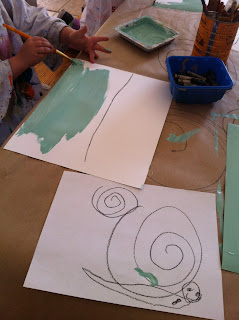In honor of Easter we painted bunnies this week! Everyone’s bunny was different and I loved them all! I did this project with my Drawing class (ages 6-12) and it’s mainly a drawing and painting project but it can easily be modified for younger ages.
Materials:
Practice paper
Pencil
Bristol Paper
Yellow, White, and Light Brown or Tan Paint (for background)
Black, White, and Blue Paint (for Bunny)
Brushes
Hairdryer (optional)
Step One
Practice your Bunny! Using the drawing sheet as reference, practice drawing the bunny. Make sure to plan out enough room on the paper for both ears and body (this can often be the most challenging part).Step Two
Draw your Bunny! Draw the bunny on Bristol paper, make sure to take your time on this step. The nice thing about this bunny is it looks good even when distorted a little.Step Three
Time to paint the background! On a palette or plate create three small piles of tan or brown, yellow, and white paint. Start by painting the bottom of the paper tan/brown, about a third way up, switch to yellow (use the same brush). Finish up the top of the page with the white, remembering to still use the same brush. (You will be painting around your bunny so blending will be tricky. This is fine as a more expressionistic background works well)Step Four
Paint your Bunny! On a plate or a palette create three small piles of black, white, and blue paint. Using some of the black, blue and white paint, mix a light grey (you’ll only need a little bit of black paint for this). Take part of the grey paint and make a new pile adding more black for a darker grey. Paint the whole bunny using the lighter grey, including over the eyes, ears, and white mouth/nose area. While the paint is still a little wet, blend some of the darker grey into the ears, shoulders, and legs of bunny; don’t worry about over blending, just a hint looks good. Once the grey paint is dry (use hairdryer for faster dry time) paint white into the ears, hands, feet, and mouth/nose area. Lastly, using black paint, put in eyes and nose.
Check out these fantastic bunnies!























